فهرست میراث جهانی یونسکو در پاکستان
میراث جهانی یونسکو در پاکستان شامل ۶ اثر فرهنگی در پاکستان میباشد. پاکستان ۲۳ ژوئیه ۱۹۷۶ به این کنوانسیون پیوست و تا سال ۲۰۲۰ افزون بر ۶ سایت ثبت شده ۲۶ سایت نیز از این کشور در فهرست آزمایشی قرار گرفتهاست.
 | |
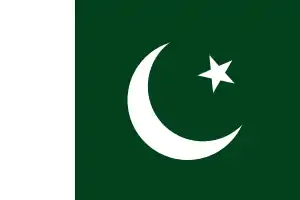 | |
| اطلاعات | |
| کشور | پاکستان |
| تاریخ ثبت | ۲۳ ژوئیه ۱۹۷۶ |
| آثار ثبت شده | ۶ |
| فهرست آزمایشی | ۲۶ |
| وبگاه | pk |
سایتهای میراث جهانی سازمان آموزشی، علمی و فرهنگی ملل متحد، یونسکو مکانهایی هستند که دارای اهمیت فرهنگی یا طبیعی هستند، همانطور که در پیماننامه میراث جهانی یونسکو، که در سال ۱۹۷۲ تأسیس شده، شرح داده شدهاست. طبق کنوانسیون یونسکو هر اثری پس از ثبت توسط این کمیته باید از سوی کشور نگهدارنده اثر مورد توجه ویژه قرار گیرد و انجام هرگونه دخل و تصرف یا اقدامی که باعث به خطر افتادن آن شود، ممنوع است.[1]
فهرست
یونسکو سایتها را با ده معیار فهرست میکند. هر ورودی باید حداقل یکی از معیارها را داشته باشد.[2]

میراث فرهنگی
میراث طبیعی
میراث طبیعی و فرهنگی
میراث در خطر
| # | نگاره | نام | موقعیت | سال | ش ثبت معیارها |
شرح | م |
|---|---|---|---|---|---|---|---|
| ۱ |  |
موهنجو دارو | ایالت سند | ۱۹۸۰ | ۱۳۸ (ii)(iii) |
[3] | |
| ۲ |  |
تاکسیلا | پنجاب | ۱۹۸۰ | ۱۳۹ (iii)(vi) |
[4] | |
| ۳ |  |
خرابههای بودایی | خیبر پختونخوا | ۱۹۸۰ | ۱۴۰ (iv) |
[5] | |
| ۴ |  |
قلعه شاهی و باغ شالیمار | پنجاب | ۱۹۸۱ | ۱۷۱ (i)(ii)(iii) |
[6] | |
| ۵ |  |
گورستان مکلی | ایالت سند | ۱۹۸۱ | ۱۴۳ (iii) |
یکی از بزرگترین شهر مردگان جهان است که در مساحتی به طول ۱۰ کیلومتر مربع در نزدیکی شهر تهته، در استان سند پاکستان واقع شدهاست. این سایت تقریباً ۵۰۰۰۰۰ تا ۱ میلیون[7] مقبره در طی یک دوره ۴۰۰ ساله ساخته شدهاست.[8] این گورستان دارای چندین بنای بزرگ تشییع جنازه است که متعلق به خانواده سلطنتی، قدیسان مختلف صوفیان و دانشمندان است. | [9] |
| ۶ |  |
دژ روهتاس | پنجاب | ۱۹۹۷ | ۵۸۶ (ii)(iv) |
[10] |
موقعیت
موقعیت مکانی میراث جهانی در پاکستان
فهرست آزمایشی
| # | نگاره | نام | موقعیت | ش ثبت معیارها |
سال | شرح | م |
|---|---|---|---|---|---|---|---|
| ۱ |  |
مسجد پادشاهی | پنجاب | ۱۲۷۷ |
۱۹۹۳ | The mosque was commissioned by فهرست پادشاهان گورکانی هند اورنگزیب in 1671. It is the second largest mosque in Pakistan after مسجد شاه فیصل and can accommodate over 100,000 worshipers in its hall and surroundings. The mosque is located opposite to قلعه شاهی and symbolizes the rich معماری گورکانی. It was the largest mosque in the Mughal empire and held the record of being the largest mosque in the world for 313 years until 1986. Under Sikh and British rule from 1799 to 1939, the mosque was used as military garrison and was severely damaged. Extensive repair work were done after 1939 and by 1960 it was restored to its original conditions. A small museum containing relics of Prophet Muhammad, his cousin Ali, and his daughter Fatimah is established inside the mosque. | [11][12] |
| ۲ | 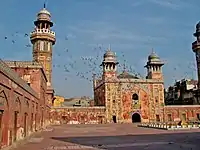 |
مسجد وزیر خان | پنجاب | ۱۲۷۸ |
۱۹۹۳ | The Wazir Khan Mosque in Lahore, is famous for its extensive faience tile work. It has been described as 'a mole on the cheek of Lahore'. It was built in seven years, starting around 1634–1635 AD, during the reign of the Mughal Emperor Shah Jehan. It was built by Hakim Shaikh Ilm-ud-din Ansari, a native of Chiniot, who rose to be the court physician to Shah Jahan and a governor of Lahore. The mosque is inside the Inner City and is easiest accessed from Delhi Gate. The mosque contains some of the finest examples of Qashani tile work from the Mughal period. | [13] |
| ۳ |  |
Tombs of Jahangir، آرامگاه آصفخان و اکبری سرای | پنجاب | ۱۲۷۹ |
۱۹۹۳ | The Tomb of Jahangir is a mausoleum built for Jahangir, who ruled the Mughal Empire from 1605 to 1627. Tomb of Asif Khan belongs to میرزا حسن آصفخان، built by Shah Jahan when Khan died in 1641 while engaged in fighting against the forces of rebel Raja Jagat Singh Pathania. The series of open courtyard tombs called Akbari Sarai, is situated between the tombs of Jahangir and Asif Khan. | [14] |
| ۴ |  |
هیران منار | پنجاب | ۱۲۸۱ |
۱۹۹۳ | Hiran Minar is set in peaceful environs near لاهور was constructed by Emperor Jahangir as a monument to Mansiraj, his favorite pet deer or antelope. | [15] |
| ۵ |  |
Ranikot Fort | ایالت سند | ۱۲۸۴ |
۱۹۹۳ | Ranikot Fort is a historical fort near Sann, known as The Great Wall of Sindh is believed to be the world's largest fort with a circumference of approximately 26 kilometres (16 mi). | [16] |
| ۶ |  |
مسجد شاهجهان | ایالت سند | ۱۲۸۶ |
۱۹۹۳ | The mosque was built in 1647, during the reign of Mughal King Shah Jahan, as a gift to the people of Sindh for their hospitality. | [17] |
| ۷ |  |
گورستان چوکندی | ایالت سند | ۱۲۸۷ |
۱۹۹۳ | The Chaukhandi tombs form an early Islamic cemetery are remarkable for their elaborate sandstone carvings. The style of architecture is typical to the region of Sindh. Generally, the tombs are attributed to the Jokhio (also spelt Jokhiya) and known as the family graveyard of the Jokhio tribe, although other, mainly Baluch, tribes have also been buried here. They were mainly built during Mughal rule sometime in the 15th and 18th centuries when Islam became dominant. | [18] |
| ۸ | 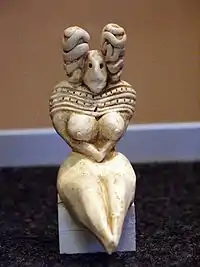 |
سایت باستانشناسی مهرگره | بلوچستان | ۱۸۷۶ (iii)(iv) |
۲۰۰۴ | Mehrgar, is one of the most important Neolithic (7000 BCE to c. 2500 BCE) sites in archaeology. It is one of the earliest sites with evidence of farming and herding in South Asia. | [19] |
| ۹ |  |
سایت باستانشناسی رحمان دهیری | خیبر پختونخوا | ۱۸۷۷ (i)(ii) |
۲۰۰۴ | Rehman Dheri is a Pre-Harappan archaeological site and one of the oldest urbanised centres found to date in South Asia, Dates back about 4000 BC. | [20] |
| ۱۰ | 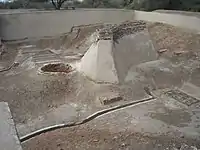 |
سایت باستانشناسی هاراپا | پنجاب | ۱۸۷۸ (ii)(iv) |
۲۰۰۴ | Harappa is an archaeological site which is site of the ancient city contains the ruins of a Bronze Age fortified city, which was part of the Cemetery H culture and the Indus Valley Civilization, centered in ایالت سند and منطقه پنجاب. | [21] |
| ۱۱ |  |
سایت باستانشناسی Ranigat | خیبر پختونخوا | ۱۸۷۹ (ii)(iv) |
۲۰۰۴ | The archaeological site of Ranigat remains of the region's largest Buddhist monastic complex reside. Structures on the site include stupas, monasteries, shrines, drainage networks, and other buildings. Ranigat is a 2500-year-old Buddhist archaeological site belonging to the Gandhara civilization and is a good evidence of the Buddhist past of the area. | [22] |
| ۱۲ |  |
شهباز گارهی | خیبر پختونخوا | ۱۸۸۰ (i)(ii)(vi) |
۲۰۰۴ | Shahbazgarhi is the location of ancient rock inscriptions that are cut into two large rock boulders and written in the Kharosthi script. They retain immense historical importance, as they appear to be the first examples of writing in South Asia. They were constructed during the 3rd Century BC, during the reign of Ashoka, the famous Mauryan emperor. | [23] |
| ۱۳ |  |
Mansehra Rock Edicts | خیبر پختونخوا | ۱۸۸۱ (i)(ii)(vi) |
۲۰۰۴ | Mansehra Rock Edicts are fourteen edicts of the Mauryan emperor Ashoka, inscribed on rocks in Mansehra. The edicts are cut into three boulders and date back to 3rd century BC and they are written in the ancient Indic script of Gandhara culture, Kharosthi. The edicts mention aspects of Ashoka’s dharma. | [24] |
| ۱۴ | 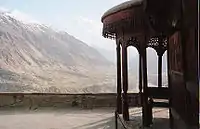 |
دژ بالتیت | گلگت-بلتستان | ۱۸۸۲ (i)(ii) |
۲۰۰۴ | Balti Fort is an ancient fort in the Hunza valley in Gilgit-Baltistan, founded in the 1st CE. The fort dates back to 700 years ago, with rebuilds and alterations over the centuries. In the 16th century the local prince married a princess from Baltistan who brought master Balti craftsmen to renovate the building as part of her dowry. | [25] |
| ۱۵ |  |
مقبره بیبی جیوندی و جلالالدین سرخپوش بخاری | پنجاب | ۱۸۸۳ (ii)(iv)(vi) |
۲۰۰۴ | The oldest of the five monuments are the 14th century AD tomb and mosque of the Central Asian Sufi Jalaluddin Bukhari located in اوچ. | [26] |
| ۱۶ |  |
آرامگاه شاه رکن عالم | پنجاب | ۱۲۸۲ (iii)(iv)(vi) |
۲۰۰۴ | Tomb of Shah Rukn-e-Alam is the mausoleum of the Sufi saint Sheikh Rukn-ud-Din Abul Fateh. The tomb was built between 1320 and 1324 CE in the pre-Mughal architectural style. | [27] |
| ۱۷ |  |
Port of Banbhore | ایالت سند | ۱۸۸۵ (iv)(v)(vi) |
۲۰۰۴ | Port of Banbhore is an ancient city dating to the 1st century BC, dates back to the Scytho-Parthian era and was later controlled by Muslims from the 8th to the 13th century, after which it was abandoned. Remains of one of the earliest known mosques in the region dating back to 727 AD are still preserved in the city. | [28] |
| ۱۸ | 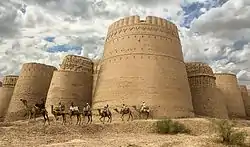 |
قلعه دراور | پنجاب | ۶۱۰۸ (iii)(v) |
۲۰۱۶ | Derawar fort was built in the 9th century by Rai Jajja Bhatti, a Rajput ruler of Bhatti clan. Other forts include (roughly from north to south) Meergarh, Jaangarh, Marotgarh, Maujgarh, Dingarh, Khangarh, Khairgarh, Bijnotgarh and Islamgarh. | [29] |
| ۱۹ | 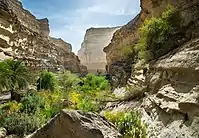 |
Hinglaj Mata mandir | بلوچستان | ۶۱۰۹ (iii)(vi) |
۲۰۱۶ | Hinglaj Mata Mandar is an ancient Hindu temple located in پارک ملی هنگول. | [30] |
| ۲۰ |  |
منظره فرهنگی سامانه کاریز | بلوچستان | ۶۱۱۰ (ii)(iv)(v) |
۲۰۱۶ | The Karez irrigation system of the Balochistan desert is a vibrant example of an ancient and still functional approach to community-based water management in an arid landscape, which originated in the 1st millennium BC. | [31] |
| ۲۱ |  |
معبد نگرپارکر جین | ایالت سند | ۶۱۱۱ (iii)(iv) |
۲۰۱۶ | The Nagarparkar landscape was an important center of جین (دین) and culture for centuries. The Karunjhar hills were a place of pilgrimage called Sardhara where there is a Jain temple of Mahadeve and a ritual pool. | [32] |
| ۲۲ |  |
Central Karakoram National Park | گلگت-بلتستان | ۶۱۱۲ (viii)(ix) |
۲۰۱۶ | It is the largest protected area in Pakistan. The Park encompasses the longest glaciers outside the polar regions. It is one of the most diverse avifauna of the mountainous regions of the world, with approximately 90 species of birds in 13 families. | [33] |
| ۲۳ |  |
پارک ملی دیوسایی | گلگت-بلتستان | ۶۱۱۵ (ix)(x) |
۲۰۱۶ | Deosai National Park is an alpine plateau with an altitude of 3500 to 5200 meters. Three important river systems originate from Deosai National Park namely; Shatung, Bara Pani and Kala Pani which form the Shigar River, an important tributary of سند (رود). | [34] |
| ۲۴ |  |
Ziarat Juniper Forest | بلوچستان | ۶۱۱۶ (x) |
۲۰۱۶ | It is the largest juniper forest (ارس آبخور) in Pakistan and is believed to be the second largest of its kind in the world. The زیارت، پاکستان Juniper Forest was declared a Biosphere Reserve in 2013. | [35] |
| ۲۵ |  |
Salt Range و Khewra Salt Mine | پنجاب | ۶۱۱۸ (v)(viii) |
۲۰۱۶ | The Salt Range originated 800 million years ago. The area is rich in paleontological finds dating as far back to some 18 million years ago with Middle Jurassic fossil dinosaur track-ways. The Salt Range has a dense clustering of historical sites and places dating back to the 4th century اسکندر مقدونی. | [36] |
جستارهای وابسته
منابع
- "UNESCO World Heritage Centre – The World Heritage Convention". UNESCO World Heritage Centre. Archived from the original on 27 August 2016. Retrieved 25 October 2015.
- "UNESCO World Heritage Centre – The Criteria for Selection". UNESCO World Heritage Centre. Archived from the original on 12 June 2016. Retrieved 17 August 2018.
- "Archaeological Ruins at Moenjodaro". World Heritage Sites. UNESCO. Archived from the original on 8 August 2012. Retrieved 7 September 2012.
- "Taxila". World Heritage Sites. UNESCO. Archived from the original on 8 August 2012. Retrieved 7 September 2012.
- "Buddhist Ruins of Takht-i-Bahi and Neighbouring City Remains at Sahr-i-Bahlol". World Heritage Sites. UNESCO. Archived from the original on 7 August 2012. Retrieved 7 September 2012.
- "Fort and Shalamar Gardens in Lahore". World Heritage Sites. UNESCO. Archived from the original on 29 November 2005. Retrieved 7 September 2012.
- "Makli Hill". ArchNet. Aga Khan Trust for Culture and the Massachusetts Institute of Technology (MIT). Archived from the original on 10 April 2019. Retrieved 17 July 2017.
- "Historical Monuments at Makli, Thatta". UNESCO. Archived from the original on 5 July 2017. Retrieved 17 July 2017.
- "Historical Monuments at Makli, Thatta". World Heritage Sites. UNESCO. Archived from the original on 8 August 2012. Retrieved 7 September 2012.
- "Rohtas Fort". World Heritage Sites. UNESCO. Archived from the original on 3 اكتبر 2018. Retrieved 7 September 2012. Check date values in:
|archive-date=(help) - "Badshahi Mosque, Lahore". World Heritage Sites. UNESCO. Archived from the original on 4 March 2020. Retrieved 18 September 2012.
- "Badshahi Mosque". Oriental Architecture. Archived from the original on 26 December 2018. Retrieved 18 September 2012.
- "Wazir Khan's Mosque, Lahore, Lahore". World Heritage Sites. UNESCO. Archived from the original on 2 August 2018. Retrieved 18 September 2012.
- "Tombs of Jahangir, Asif Khan and Akbari Sarai, Lahore". World Heritage Sites. UNESCO. Archived from the original on 1 February 2018. Retrieved 18 September 2012.
- "Hiran Minar and Tank, Sheikhupura". World Heritage Sites. UNESCO. Archived from the original on 8 August 2012. Retrieved 18 September 2012.
- "Rani Kot Fort, Dadu". World Heritage Sites. UNESCO. Archived from the original on 25 December 2019. Retrieved 18 September 2012.
- "Shah Jahan Mosque, Thatta". World Heritage Sites. UNESCO. Archived from the original on 3 اكتبر 2018. Retrieved 18 September 2012. Check date values in:
|archive-date=(help) - "Chaukhandi Tombs, Karachi". World Heritage Sites. UNESCO. Archived from the original on 8 August 2012. Retrieved 18 September 2012.
- "Archaeological Site of Mehrgarh". World Heritage Sites. UNESCO. Archived from the original on 8 August 2012. Retrieved 18 September 2012.
- "Archaeological Site of Rehman Dheri". World Heritage Sites. UNESCO. Archived from the original on 8 August 2012. Retrieved 18 September 2012.
- "Archaeological Site of Harappa". World Heritage Sites. UNESCO. Archived from the original on 8 August 2012. Retrieved 18 September 2012.
- "Archaeological Site of Ranigat". World Heritage Sites. UNESCO. Archived from the original on 25 اكتبر 2012. Retrieved 18 September 2012. Check date values in:
|archive-date=(help) - "Shahbazgarhi Rock Edicts". World Heritage Sites. UNESCO. Archived from the original on 25 اكتبر 2012. Retrieved 18 September 2012. Check date values in:
|archive-date=(help) - "Mansehra Rock Edicts". World Heritage Sites. UNESCO. Archived from the original on 2 September 2012. Retrieved 18 September 2012.
- "Baltit Fort". World Heritage Sites. UNESCO. Archived from the original on 8 August 2012. Retrieved 18 September 2012.
- "Tomb of Bibi Jawindi, Baha'al-Halim and Ustead and the Tomb and Mosque of Jalaluddin Bukhari". World Heritage Sites. UNESCO. Archived from the original on 12 December 2020. Retrieved 18 September 2012.
- "Tomb of Hazrat Rukn-e-Alam, Multan". World Heritage Sites. UNESCO. Archived from the original on 8 August 2012. Retrieved 18 September 2012.
- "Port of Banbhore". World Heritage Sites. UNESCO. Archived from the original on 31 December 2019. Retrieved 18 September 2012.
- "Derawar and the Desert Forts of Cholistan". UNESCO. Archived from the original on 26 December 2016. Retrieved 26 December 2016.
- "Hingol Cultural Landscape". UNESCO. Archived from the original on 26 December 2016. Retrieved 26 December 2016.
- "Karez System Cultural Landscape". UNESCO. Archived from the original on 26 December 2016. Retrieved 26 December 2016.
- "Nagarparkar Cultural Landscape". UNESCO. Archived from the original on 10 May 2017. Retrieved 26 December 2016.
- "Central Karakorum National Park". UNESCO. Archived from the original on 26 December 2016. Retrieved 26 December 2016.
- "Deosai National Park". UNESCO. Archived from the original on 26 December 2016. Retrieved 26 December 2016.
- "Ziarat Juniper Forest". UNESCO. Archived from the original on 26 December 2016. Retrieved 26 December 2016.
- "The Salt Range and Khewra Salt Mine". UNESCO. Archived from the original on 26 December 2016. Retrieved 26 December 2016.
پیوند به بیرون
- (انگلیسی) میراث جهانی یونسکو در پاکستان
This article is issued from Wikipedia. The text is licensed under Creative Commons - Attribution - Sharealike. Additional terms may apply for the media files.

